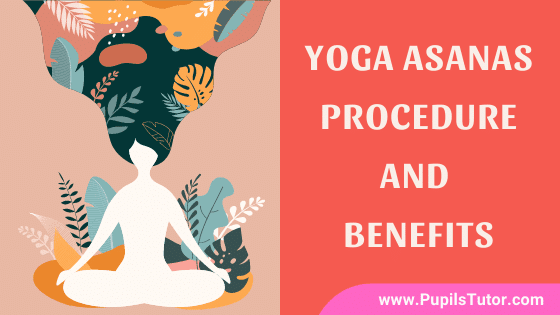
Yoga Asanas Procedure and Benefits
There is a large number of asanas. According to Charandas, there are 84,000 asanas.
- Some of the asanas are very useful and important from the viewpoint of the physical, mental, and spiritual growth of an individual.
Some Important Asanas Are:
1. Sitting Position Asanas
a. Padamasana (Lotus Pose)
Posture
|
|
Position
|
|
Method
|
- Sit and spread out both legs to the front. Hand to be one the side palms on the ground and fingers joined together.
- Slowly lift the right toe with the left hand and right ankle with the right hand and place it on the left thigh.
- In the same manner, hold the left toe and ankle. Place it on the right thigh.
- Place the hands on the knees in a meditative posture. Close the eyes or look to the front.
- In the reverse order remove the left leg first from the thigh.
- Then remove the right leg too and assume the initial position.
|
General Benefits
|
- Padmasana is used for mediation, prayer, and worship and for pranayama practice.
- It develops physical and mental stability.
- This asana helps the players to obtain mental control.
- Padmasana keeps a person young.
|
Physiological Benefits
|
- The abdominal region receives more supply of blood.
- Padmasana improves the digestion process.
- It activates the functions of kidney.
|
Therapeutic Benefits
|
- Padmasana relieves constipation, and indigestion.
- It is a very good asana for curing knee ailments.
- Padmasana is useful in curing the flatulence i.e gastric trouble in the stomach.
- It also cures pile complaints.
|
b. Matsyasana (Fish Pose)
Posture
|
|
Position
|
|
Method
|
- Slowly bring the right leg and place it on the left thigh.
- The heel of the right foot should as much as possible touch the groin.
- Slowly bring the left leg and place it on the right thigh.
- The heel of the left should as much as possible touch the groin.
- With the support of the arms and elbows, slowly and backward and lie down flat on the ground.
- Slowly bring the hands and place the palms near the shoulder (elbow facing upward).
- With the help of hand support slowly lift the chest upwards and rest the centre of the head support slowly lift the chest upwards and rest the centre of the head on the ground and arch the back as much as possible.
- Slowly bring the hands forward and place the palms on the feet.
|
General Benefits
|
- Matsyasana enlarges the thoracic cage.
- It strengthens the spinal cord.
- It gives more flexibility to the neck region, hip, and knee joints.
|
Physiological Benefits
|
- Matsyasana allows the flow of more blood to the thoracic region.
- It regulates the free flow of the breathing process.
- It regulates the function of the thyroid gland.
|
Therapeutic Benefits
|
- Matsyasana is useful in curing asthma.
- It is very good asana for backache patients.
- It is useful for curing headaches and sinus problems.
- It helps to reform the disorder of kyphosis.
|
c. Yogamudhra ( The Psychic Union Pose)
Posture
|
|
Position
|
|
Method
|
- Slowly bring the right leg and place it on the left thigh.
- The heel of the right foot should as much as possible touch the groin.
- Slowly bring the left leg and place it on the right thigh.
- The heel of the left foot should as much as possible touch the groin.
- Slowly bring hands back and hold the right hand at wrist by the left hand.
- Slowly bend the trunk forward until the forehead touched the ground or nearly touches the ground.
|
General Benefits
|
- This Yoga asana is very useful for focusing our mind on a particular object.
- Separates the individual vertebrae from each other, thus allowing the spinal column more flexible.
|
Physiological Benefits
|
- Yogasana activates the kidneys, liver, pancreas and adrenal glands.
- It is useful for a good flow of fresh blood to the spinal nerves and muscles.
- It increases the functions of the circulatory and respiratory systems.
- The entire nervous system are toned up.
|
Therapeutic Benefits
|
- This Yogasana is useful for curing obesity.
- It is a good remedy for constipation.
- It is a very good asana for pile complaints.
- It can check and even cure diabetes.
|
d. Paschimottanasana (Seated Forward Bend)
Posture
|
|
Position
|
|
Method
|
- Slowly bring the hands upwards above the head sideways (without bending elbows).
- Slowly bring the hands downward on forwarding direction and try to catch the big toes with fingers (if this is not possible try to hold the ankles, as near to the feet as possible).
- Slowly bend the body forward and try to touch the knees with the forehead (without any strain anywhere in the body.)
|
General Benefits
|
- Paschimottanasana strengthens the hamstring, calf, and back muscles.
- It gives more flexibility to the vertebral column.
- It removes excess fat in the abdominal region.
|
Physiological Benefits
|
- It is useful for a good flow of fresh blood to the spinal nerves and muscles.
- Paschimottanasana activates the kidneys, liver, pancreas, and adrenal glands.
- It increases the functions of the circulatory and respiratory systems.
|
Therapeutic Benefits
|
- Paschimottanasana is a good remedy for constipation
- It is a very good asana for the pile complaints.
- It can check and even cure diabetes.
- It is useful for curing obesity.
|
2. Standing Position Asanas
a. Trikonasana (Revolved Triangle Pose)
Posture
|
|
Position
|
|
Method
|
- Place the right leg to the right side in such a way that the legs are 3 to 4 feet apart.
- Slowly raise the arms sideward up to the shoulder level without any bend at the elbows with facing down.
- Slowly bend sideways towards the right leg and try to touch the right foot or floor as much as possible with the right hand.
- Keeping the left arm perpendicular to the floor with the palm facing forward. Slowly turn the head and lookup.
- If you feel stiffness at the neck, keep the head facing forward.
|
General Benefits
|
- Trikonadana reduces the excess fat in the sideways
- It improves the balancing power in the body
|
Physiological Benefits
|
- Trikonadana regulates the digestive and circulatory systems
- The spinal nerves are toned up thus it develops the concentration
|
Therapeutic Benefits
|
- It is very useful in curing some of the functional and organic disorders like acidity, arthritis, heart diseases etc.
- Trikonadana is helpful to reform the vertebral disorders scoliosis.
|
3. Prone Position Asanas
a. Salabhasana ( Locust Pose)
Posture
|
|
Position
|
|
Method
|
- Slowly raise the head, and place your chin on the floor
- Gently raise the thighs and place the hands below the thighs with palms touching the floor.
- Slowly raise both legs one or two feet above the ground level.
- Maintain the pose for a few seconds without any oscillation.
- In the final position try to relax the whole body as much as possible.
|
General Benefits
|
- Salabhasana will strengthen the back and abdomen muscles
- Salabhasana gives more flexibility to lower vertebrae in the spinal column
- It develops the balancing power in the body.
- It helps to make the maximum range of movements in all directions in the hip joint.
|
Physiological Benefits
|
- Salabhasana brings a large supply of blood to the kidneys, heart, and lungs.
- It activates the functions of liver and pancreas
- It regulates the respiratory process.
- It activates the functions of the digestive and excretory system, particularly the large and small intestine.
|
Therapeutic Benefits
|
- Salabhasana relieves the low back pain to a great extent
- It plays a vital role in curing impotency
- It is a good remedial asana for indigestion problem.
- It is useful in curing constipation
- It is a very good asana for arthritis disorder
|
b. Bhujangasana ( Cobra Pose)
Posture
|
|
Position
|
|
Method
|
- Slowly bring the arms sidewards nearer to the chest and place the palms on the floor with fingers pointing towards the head.
- Slowly raise and make an arch backward on the head, neck, and shoulder as much as possible.
- Slowly raise the chest as mush a possible in such a way that the lower abdomen should be in touch with the ground.
|
General Benefits
|
- Bhujangasana strengthens the neck and back muscles.
- It will enlarge the thoracic cavity.
- It will give more flexibility to the vertebral column.
- It will develop concentration and memory power.
|
Physiological Benefits
|
- It regulates the free flow of the breathing process.
- Bhujangasana activates the functions of the thyroid gland.
- It allows the flow of more blood to the thoracic region.
|
Therapeutic Benefits
|
- Bhujangasana stimulates the digestion.
- It is a very good asana for neck pain
- It relocates the slipped discus
- It is a good remedy for paralysis and rheumatism.
- It helps to reform the vertebral disorder of kyphosis
|
c. Dhanurasana (Bow Pose)
Posture
|
|
Position
|
|
Method
|
- Gently fold the right leg at knee and hold ankle with right hand
- Slowly the left leg at the knee and hold the ankle with the left hand
- Raise the head, chest and thighs as high as possible by gradual application of force on the hands and legs
- Raise the body and make a perfect back arch on the vertebral column as much as possible.
|
General Benefits
|
- Dhanurasana lessens the spinal column
- It develops the balancing power in the body
- It will strengthen the back and abdomen muscles
|
Physiological Benefits
|
- Dhanurasana stimulates the endocrine glands
- It brings a large supply of blood to the kidneys, heart and lungs
- Particularly it activates the function of liver, kidney and pancreas
|
Therapeutic Benefits
|
- Dhanurasana is useful for women suffering from irregular periods.
- It is a very good asana for curing many disorders like asthma, diabetic, constipation, sexual debility etc.,
|
4. Supine Position Asanas
a. Sarvangasana (Shoulder Stand)
Posture
|
|
Position
|
|
Method
|
- Raise the legs slowly upto 90 degree, and hold them in the position for a few seconds.
- While raising maintain the legs straight and together.
- Raise the trunk slowly the support of the hands with the palms placed at the centre of the back.
- Hold the body at an angle of 90 degree with head, shoulder and upper arm alone on the ground.
- Maintain the same body position.
- Keep the total body perpendicular to the ground.
|
General Benefits
|
- Sarvangasana develops memory and concentration power.
- It gives more flexibility to the spinal column.
- It reduces the excess fat in the stomach region.
|
Physiological Benefits
|
- Sarvagasana particularly stimulates the thyroid gland.
- It increases the more amount of blood flow to the head region.
- It has a beneficial effect on the endocrine and digestive system.
- It activates the functions of the pituitary gland, which is the master gland that controls all the ductless glands functions.
|
Therapeutic Benefits
|
- Sarvangasana relieves headaches, asthma, etc.
- It regulates the nervous debility
- It is a very good asana to relieve impotency and throat ailments.
- It is a good remedy for menstrual disorders, varicose veins and obesity.
|
b. Halasana (Plough Pose)
Posture
|
|
Position
|
|
Method
|
- Raise the legs slowly upto 90-degree and hold them in the position for a few seconds.
- Raising the legs straight and together.
- Gently lower the legs behind the head until the toes are touching the ground.
- Extend the feet a little further behind the head with toes pointing outward.
|
General Benefits
|
- Halasana is extremely beneficial to the spinal column
- It reduces the excess fat at the stomach region.
- It develops the memory and concentration power.
|
Physiological Benefits
|
- It regulates the functions of the circulatory and respiratory systems.
- It increases the more amount of blood flow to the head region.
- It activates the functions of pituitary gland, which is the master gland that controls all the ductless glands functions.
|
Therapeutic Benefits
|
- Halasana relieves backache, low back pain, and rheumatism,
- It is a good remedy for menstrual disorders and obesity.
- It regulates the nervous debility
|
B.EdB.Ed NotesHealth EducationTags:
Yoga Asanas Procedure and Benefits Notes
Explain Psychological And Therapeutic Benefits Of Different Yoga Asanas Notes For B.Ed In English Medium
(Different Yoga Asanas – Their Position, Posture, Method, Procedure, Health Benefits | Psychological And Therapeutic Benefits Of Different Yoga Asanas) Notes And Study Material, PDF, PPT, Assignment For B.Ed 1st and 2nd Year, DELED, M.Ed, CTET, TET, Entrance Exam, All Teaching Exam Test Download Free For Health Physical And Yoga Education Subject.




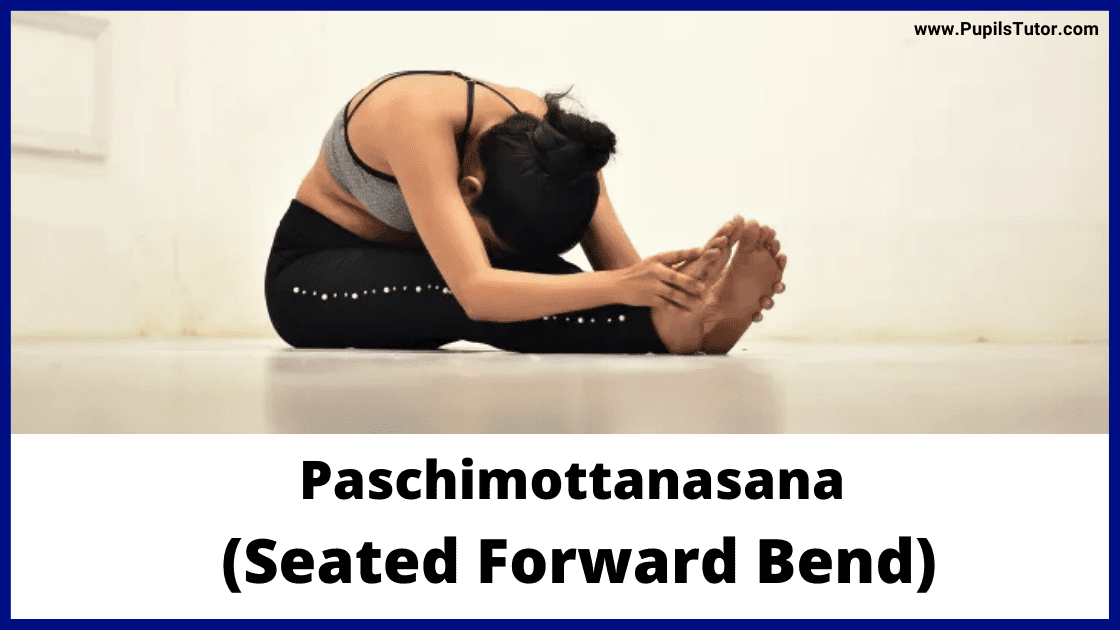
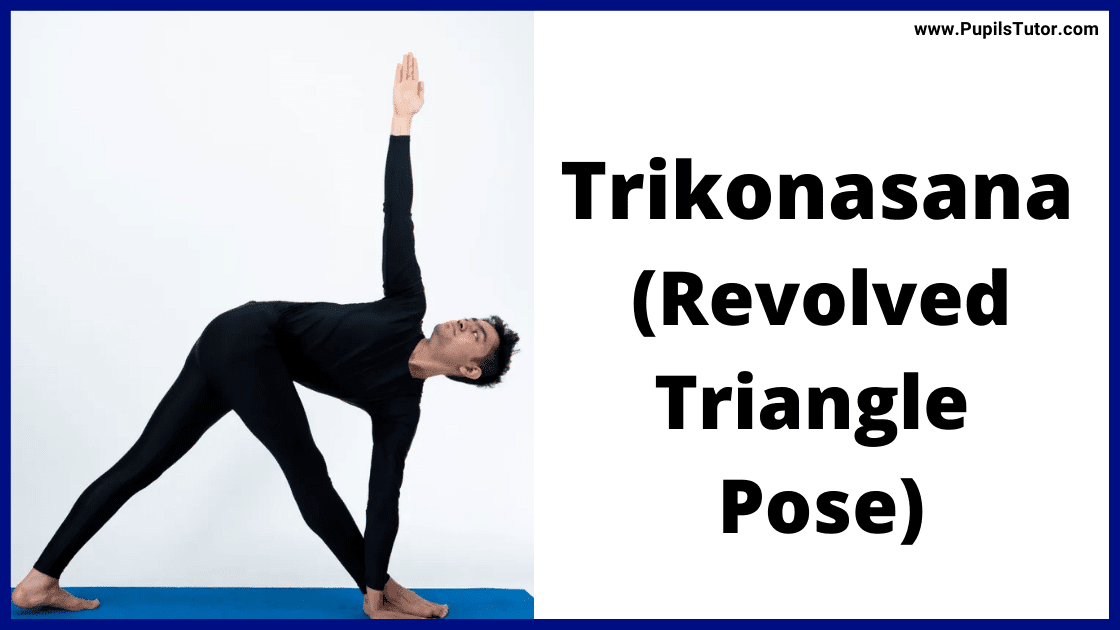


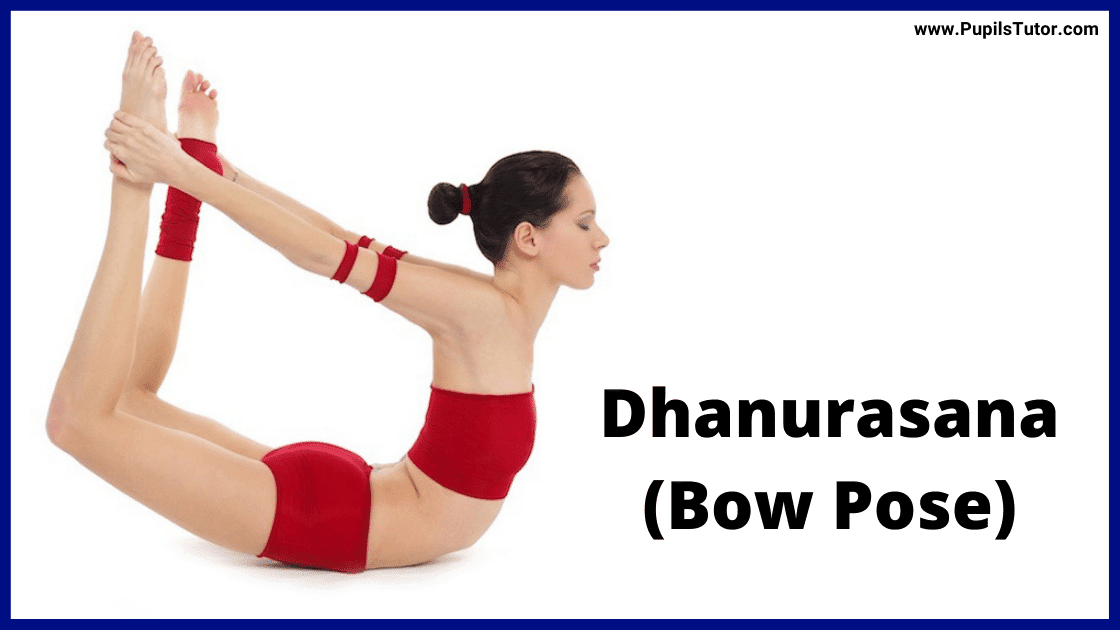

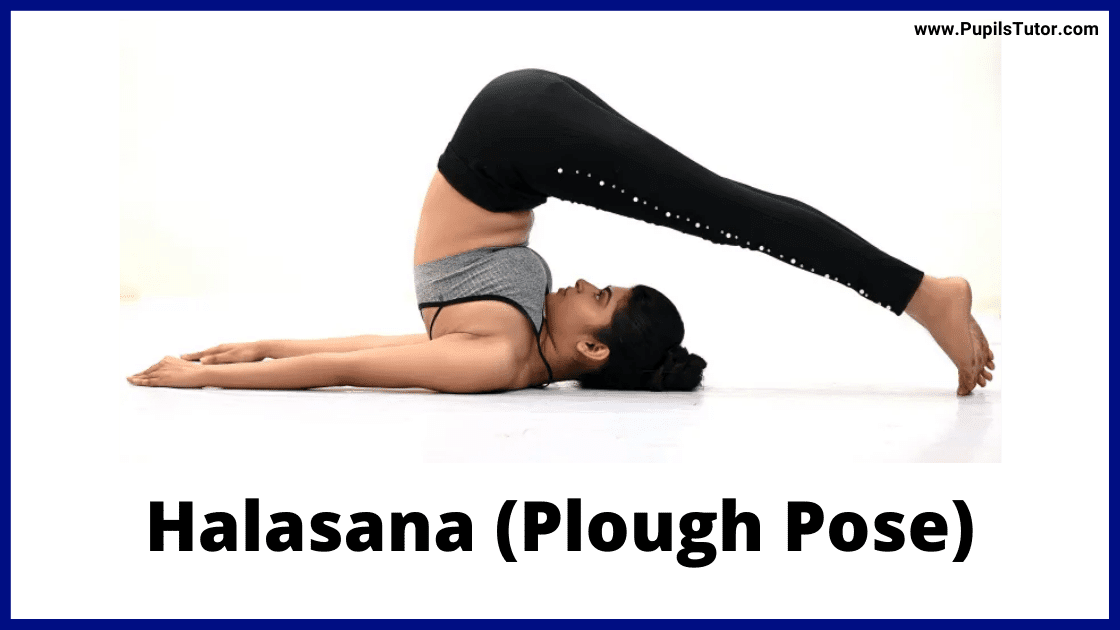


Share You Thoughts And Suggestions In The Comment Box